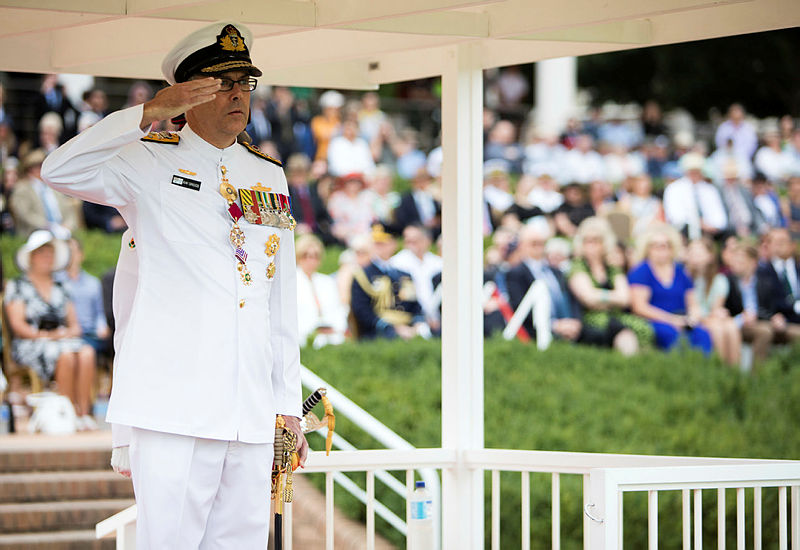Talking to the chiefs: Ray Griggs (part 1)
Posted By Brendan Nicholson on May 31, 2017 @ 11:00

In 2002 Ray Griggs, then captain of the frigate HMAS Arunta, took his ship to the Persian Gulf to help enforce UN sanctions against Iraq. The Anzac-class frigate was equipped with eight air defence missiles and a dated conventional radar system.
Arunta is back in the Middle East now with 32 missiles, a front line helicopter and phased array radar system developed in Australia—one of the world’s best. ‘It’s a fantastic radar, amazing!’ says Griggs, now vice chief of the ADF. ‘The frigate’s got Harpoon and a whole lot of other things we did not have then.’
The dramatic increase in the potency of Australia’s frigates, and in their ability to defend themselves, after a highly effective upgrade illustrates the growing maturity of the ADF and its ability to do much more with existing platforms while preparing to take on billions of dollars’ worth of new equipment, Vice Admiral Griggs tells The Strategist.
‘You can see the progression there,’ says Griggs. ‘We’ve been an ADF on operations since East Timor in 1999. We rolled out of East Timor pretty much straight into Afghanistan and then into Iraq, and then back into Afghanistan and now back to Iraq along with a continuous naval contribution since 1990.’
‘Along the way we’ve fundamentally learned the lessons of the “fitted for but not with” era and the ADF is significantly more capable, in relative terms, that it was 15 years ago.’
The vice chief is the Defence organisation’s ‘senior joint champion’, a role given many more teeth, or greater bite, after the First Principles Review’s strong focus on integration and interoperability of the Army, Navy and the RAAF and all of their personnel and equipment. The review nominated the vice chief as the officer running the project that’s intended to make the ADF a more effectively ‘joint’ force. Previously it lacked an organisationally strong champion, says Griggs.
Such capabilities include ensuring the benefits of the ‘fifth generation’ Air Force are harnessed across the whole ADF with ‘enablers’ such as extensive networking to allow personnel and their equipment to communicate rapidly and in great detail. Such projects, crucial as they are, lack the obvious scale of major developments and they have sometimes languished as a consequence.
‘As we move into the era of fifth generation capabilities such as the Growler [electronic warfare aircraft], the P8 [Poseidon maritime patrol aircraft] and the Joint Strike Fighter, their integration across the ADF is crucial,’ says Griggs. ‘Fifth generation is not about an aircraft but a whole system.’
Apart from the obvious benefit of improving the coordination on operations of units from the Army, Navy and RAAF, ‘jointness’ is also crucial because the cost to the taxpayer of duplicating capabilities across the three services isn’t sustainable, Griggs says.
Griggs also feels that the commonly used term, ‘joint’, underplays the role of Defence civilians. While those in the armed services deliver ‘kinetic’ effects, the input of those in defence intelligence, for instance, is just as crucial, he says. ‘I prefer the term “integrated” because that’s what we are trying to achieve. We’re not trying to do things jointly, we’re trying to achieve an integrated effect and the big shift, to fifth generation, brings a truly networked approach to how we go about our business.’
‘We’ve talked for 10 or 15 years about network centric warfare,’ says Griggs. ‘Now we have capabilities that completely rely on the network working as an integrated whole.’ That makes the joint force much more effective. ‘There’s very little we do that’s single service orientated.’
And using fifth-generation technology to gather intelligence on operations, and in preparing for ADF operations, demands a significant amount of information be fed to it so that it can do its job effectively. ‘So the whole notion of intelligence mission data drives a team effort to produce and use the data and to disseminate it.’
In the Middle East, the RAAF’s Air Task Group is directed by Australian troops when it carries out strikes in support of Iraq forces on the ground. ‘You can’t have a radio network for the army and another for the air force,’ says Griggs. ‘It’s got to be integrated, all linked together.’
Griggs says the ADF is engaged in two major integration challenges. One is to ensure it has horizontal integration across the force so the different parts of it can talk to each other and work together. ‘In a defence of Australia scenario that’s absolutely crucial because that’s how we would fight—as an ADF. But 98 percent of the time we operate in coalitions so, while it’s important to have horizontal integration, it’s also important to have it in a vertical sense in the coalition.
It’s absolutely crucial that the RAAF’s Air Task Group in the Middle East is completely locked in to the coalition command and control structure, says Griggs. ‘And it’s important that our frigate in the Middle East is locked in to the (US) Fifth Fleet structures and that it’s interoperable with other nation’s ships.’
‘Effective integration is a massive force multiplier.’
Article printed from The Strategist: https://www.aspistrategist.org.au
URL to article: https://www.aspistrategist.org.au/talking-chiefs-ray-griggs/
Click here to print.